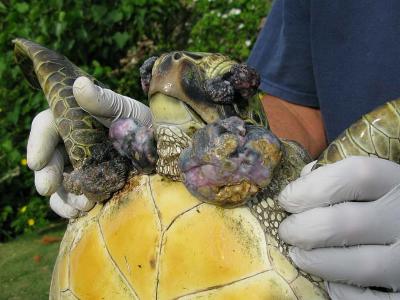Researchers find organic pollutants not factor in turtle tumor disease

Persistent organic pollutants do not make Hawaiian green sea turtles more susceptible to the large tumors associated with fibropapillomastosis seen in this specimen. Credit: Keller/NIST
In a new study,* researchers from the Hollings Marine Laboratory (HML), a government-university partner facility in Charleston, S.C., and from university and federal collaborators in Hawaii demonstrated POPs are not, in fact, a co-factor linked to the increasing number of green sea turtles afflicted with FP.
POPs are a large group of man-made chemicals that, as their name indicates, persist in the environment. They also spread great distances through air and water, accumulate in human and animal tissues, increase in concentration up food chains, and may have carcinogenic and neurodevelopmental effects.
POPs include banned substances such as DDT and toxaphenes, once used as pesticides; polychlorinated biphenyls (PCBs), once used as insulating fluids; and polybrominated diphenyl ethers (PDBEs), still used as flame retardants. Two previous studies attempting to link POPs and FP were unable to rule out the impact of the pollutants on the disease.
“We wanted to do a thorough study looking at a large, statistically valid population of turtles and using methods that could detect even tiny levels of POPs in their tissues,” says National Institute of Standards and Technology (NIST) research biologist Jennifer Keller, lead author on the paper appearing in the journal Environmental Science and Technology.
Keller and her colleagues collected turtle blood samples at four locations across Hawaii, each one having a different prevalence of FP—none, low, moderate and high—in the marine turtle population residing there. “We analyzed the plasma for 164 different organic compounds to see if POP concentrations increased with increasing prevalence of FP,” Keller says. “We also looked at the levels of halogenated phenols, chemicals which can come from either man-made [POP] sources or naturally from the green turtle's main food source, marine algae.”
The researchers discovered that increasing POP concentrations did not correspond with a like rise in the numbers of FP tumors observed. “Our findings show that POPs are not the trigger for FP, so we can eliminate these pollutants from future studies trying to explain why the disease is more common in certain areas or why its prevalence is changing with time,” Keller says.
As for halogenated phenols, the team found that the sampled turtles did have detectable concentrations of the compounds. “While it's a novel discovery for sea turtles, we believe that these phenols are likely from the turtle's diet of algae rather than man-made POPs,” Keller explains.
Collaborating with Keller were researchers from Hawaiian branches of two federal agencies, the National Marine Fisheries Service and the U.S. Geological Survey, as well as from Hawaii Pacific University and the Hawaii Preparatory Academy.
The HML is a unique partnership of governmental and academic organizations including NIST, NOAA's National Ocean Service, the South Carolina Department of Natural Resources, the College of Charleston and the Medical University of South Carolina.
*J.M. Keller, G.H. Balazs, F. Nilsen, M. Rice, T.M. Work and B.A. Jensen. Investigating the potential role of persistent organic pollutants in Hawaiian green sea turtle fibropapillomatosis. Environmental Science and Technology. Accepted for publication June 25, 2014, DOI: 10.1021/es5014054
Media Contact
More Information:
http://www.nist.govAll latest news from the category: Life Sciences and Chemistry
Articles and reports from the Life Sciences and chemistry area deal with applied and basic research into modern biology, chemistry and human medicine.
Valuable information can be found on a range of life sciences fields including bacteriology, biochemistry, bionics, bioinformatics, biophysics, biotechnology, genetics, geobotany, human biology, marine biology, microbiology, molecular biology, cellular biology, zoology, bioinorganic chemistry, microchemistry and environmental chemistry.
Newest articles

A universal framework for spatial biology
SpatialData is a freely accessible tool to unify and integrate data from different omics technologies accounting for spatial information, which can provide holistic insights into health and disease. Biological processes…

How complex biological processes arise
A $20 million grant from the U.S. National Science Foundation (NSF) will support the establishment and operation of the National Synthesis Center for Emergence in the Molecular and Cellular Sciences (NCEMS) at…

Airborne single-photon lidar system achieves high-resolution 3D imaging
Compact, low-power system opens doors for photon-efficient drone and satellite-based environmental monitoring and mapping. Researchers have developed a compact and lightweight single-photon airborne lidar system that can acquire high-resolution 3D…





















